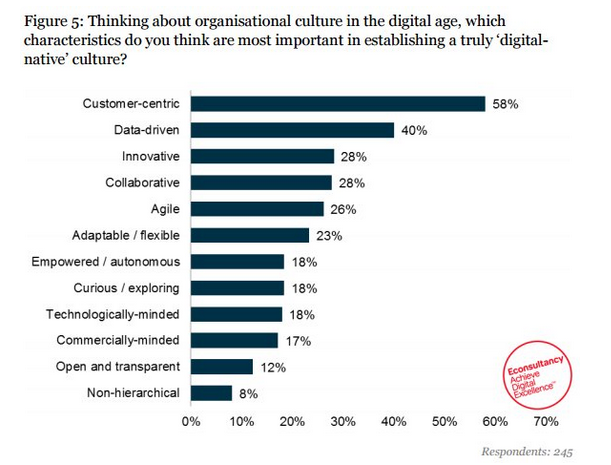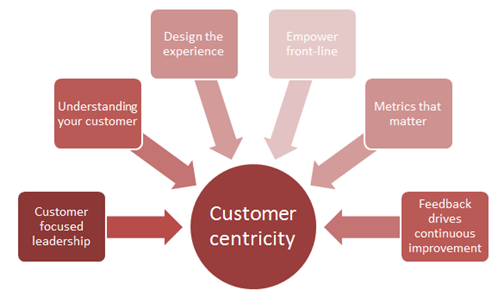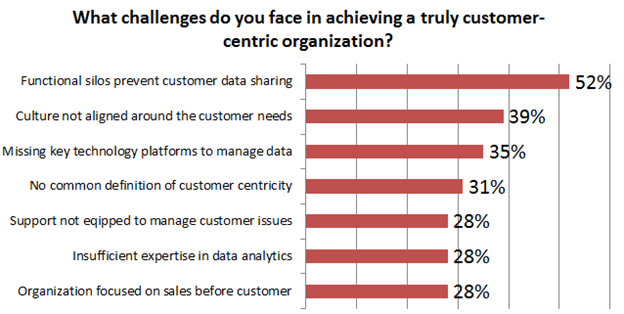Register now or log in to join your professional community.

Customer Centered Company- Actions taken by a business to support its sales and service staff in considering client needs and satisfaction their major priorities
Customer Centered companies make their strategies based on customers' needs and responds rather than concentrating only on the competitor.

Customers main source of the ideas of development and improvement.Basis of the assessment is to satisfy the customer, not the internal goals.Training focuses on personal skills in addition to technical skills.Teamwork in order to achieve outstanding performance.Participation in decision making at all levels.Upgrade according to merit rather than seniority.Balance between the needs and expectations of both external and internal customer client.Organizational culture and administrative support continuously.

agree with ms. ghada on her answer

A customer-centric or centered company those which prioritizes its customers see greater business results, earn more word-of-mouth praise, and bring more innovative products to market. But while many companies claim to be customer-centric, the real number is actually much lower. So how do you know if the company is providing an experience that delights its customers. There are five features to look for when identifying truly customer-centric organizations:
Customer-centric organizations make it easy for customers to connect with them, wherever, whenever they want to. That means making sure your site and customer community are mobile and search optimized, that you have a presence on relevant social media sites, and that it’s obvious to your customers how to get in touch with you. It also means communicating in a way that’s friendly and easy for them to understand, not cluttering it up with industry jargon and opaque responses.
Social media has had a major impact on your customers’ expectations of you. Not only do they expect a response from you every time they reach out to you in any channel they choose to do, they expect it quickly! You can keep this manageable by only having a presence on as many channels as you can reasonably monitor and funneling these conversations into your customer community. And remember, it’s not enough to just respond the first time they reach out. You need to respond every time, and circle back to close the loop with them whenever there’s an update.
It doesn’t matter how quickly you respond if you don’t respond with empathy! Think about the way you’d talk to a friend with a problem. Yes, you want to help them solve it. But first you want to make sure they know you’re listening, you understand, and you care. Use the same approach with your customers, and they’ll remain loyal to you, just like those friends.
It’s hard to provide your customers with fast, truthful information if your departments exist in disconnected silos. One might want to know when your next product will be released; another might be wondering where you got that stat in your latest infographic; someone else may need more information about the features included in a particular package. Unless your company has a good way to communicate and collaborate internally, you won’t be able to provide these answers quickly or honestly. We use an internal community called The Satisfactory for this.
The whole point of opening up your company to customer feedback, ideas, and yes, even criticism, is to let it guide your internal thought and development processes. Sometimes your customers will say the one thing you hope they don’t. That doesn’t mean you have to build what they’re asking for every time.

Thanks
Totally agree with the answer given by Mrs. Ghada

A customer-centric company is more than a company that offers good service. Both Amazon and Zappos are prime examples of brands that are customer centric and have spent years creating a culture around the customer and their needs. Their commitment in delivering customer value is genuine – In fact, Zappos is happy to fire employees if they do not fit within their customer centric culture!
The importance of being customer centric continues to grow.
Econsultancy recently asked what the most important characteristic is in order to establish a truly “digital-native” culture. The answer to that was question and leading the responses with 58% was to be customer centric.

However, executing a customer-centric strategy doesn’t happen overnight. You have to start somewhere, and this blog post is intended to guide you in to achieving this.
What does it mean to be customer centric?Customer centricity is not just about offering great customer service, it means offering a great experience from the awareness stage, through the purchasing process and finally through the post-purchase process. It’s a strategy that’s based on putting your customer first, and at the core of your business.

When you put your customer at the core of your business, you collect a wealth of data within your CRM software, giving you a full 360 view of the customer, which you can then use to enhance the customer experience.
For example:
Not only does focusing on the customer make sound business sense, but research by Deloitte and Touche found that customer-centric companies were 60% more profitable compared to companies that were not focused on the customer.
The challenges of becoming a customer centric organizationThe power shift between brand and customer happened during the economic downturn. Customers became more selective in which brand they chose to spend their money with – The winning brands were the ones who treated their customers with respect, with great service, and built a relationship with them that still exists today.
And during the same time as the recession, social media exploded onto the scene and mobile became a major part of the customer journey. Customers can now compare products and services in real time and across multiple devices, which has presented a huge challenge for many brands.
Research has found that companies are struggling with this change and are unable to become a customer-centric organization – with the biggest challenge not being able to share customer information across departments.

Most companies do not have all of the components in place to claim they are customer centric.
You need to start with your customers, not your products and focus on what your customers want to do. By designing your company from the customer’s perspective, your organization will be focused on the customer’s needs.
4 Best Practices to becoming a Customer Centric CompanyBy being customer centric, you will want to anticipate customers’ needs and delight them with products and services they may not have thought of, but will immediately fall in love with (ie, Apple’s iPhone or iPad). Thus, the customer centric brand creates products, processes, policies and a culture that is designed to support customers with a great experience as they are working towards their goals.
The four best practices that stand out regarding customer-centricity are:
Not every organization will have the same customer metrics to measure customer centricity. However, the two most important customer centric metrics that should be carefully monitored are churn rate and customer lifetime value.
Acquiring new customers is getting more difficult. Therefore, more companies are investing in keeping existing customers instead of trying to find new ones:
Companies with a high retention rate grow faster. The key to success is to understand why people leave, and why people remain customers.
To calculate the churn rate, measure the number of customers who left in the last 12 months divided by the average number of total customers (during the same period).
For a customer-centric business, the most valuable asset is the customer. The profits generated during the retention phase are often known as customer lifetime value or CLV. Customer Lifetime Value (CLV) measures the profit your organization makes from any given customer.
To calculate CLV, take the revenue you earn from a customer, subtract the money spent on serving them and adjust all of the payments for time value of money. Another way to calculate it is to take average order value and repeat purchase rates. For example, if your average order value is $100 and the repeat purchase rate per customer is 20% your estimated CLV is $125.
Calculating the customer lifetime value helps you understand why it makes sense to invest in keeping your customers. It’s a great way to get an understanding of your customer portfolio and to segment your customer.
ConclusionThe shift towards becoming a truly customer centric organization is both complex and long but, do not be put off by this as even the smallest changes to policy and processes can have a significant benefit for both employee and your customer.
Being a customer centric organization is the Holy Grail towards unlocking the true potential of customer value. Always put yourself in the shoes of the customer and minimize customer effort and maximize customer value.
I apologize for the answer, I leave the answer to experts specialists in this field that's not my specialty field

Ability of the company to give the customer a WOW experience and readiness to listen to the customers.

When the fulcrum of the company is it's customers.

agree with Yaqoub Alomar<<<<<<<<<<<<<<<<<<<<<<<<

I agree with your answer Mrs. Ghada ............................





Do you need help in adding the right keywords to your CV? Let our CV writing experts help you.